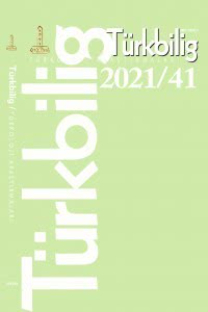DEDE KORKUT HİKȂYELERİNDEKİ BİRLEŞİKLER
Dede Korkut hikȃyeleri, birliktelik yapıları, birleşikler, sözlüksel eş dizimlilik, dilbilgisel eş dizimlilik, deyim
Composites in Dede Korkut Stories
Dede Korkut hikȃyeleri co-ordinate constructions, composites, collocation, lexical colligation, grammatical colligation, idiom.,
___
- Cowie, Anthony Paul (1981). The Treatment of Collocations and Idioms in Learners' Dictionaries. Applied Lingusitics, 2, 223-235.
- Cowie, Anthony Paul (1988). Stable and Creative Aspects of Vocabulary Use. London: Longman.
- Cowie, Anthony Paul (1994). Phraseology, The Encyclopaedia of Language and Linguistics. (Ed. R. E. Asher), Oxford and New York: Pergamon, 3168-3171.
- Ergin, Muharrem (1997). Dede Korkut Kitabı I, II. Ankara: TDK.
- Evert, Stefan (2005). The Statistics of Word Cooccurrences: Word Pairs and Collocations, Ph.D. thesis, Institut für maschinelle Sprachverarbeitung Universität, Stuttgart. https://elib.uni-stuttgart.de/bitstream/11682/2573/1/Evert2005phd.pdf, 10.06.2020.
- Fontenelle, Thierry (October 1994). What on Earth are Collocations? An Assessment of the Ways in Which Certain Words Co-occur and Others Do not, English Today, 40, X(IV), 1-10.
- Howarth, Peter (1993). A Phraseological Approach to Academic Writing. London: Macmillan.
- Kaçalin, Mustafa (2017). Oğuzların Diliyle Dedem Korkut. Ankara: TDK.
- Lehecka, Tomas (2015). Collacation and Colligation, Handbook of Pragmatics. Volume 19, 1-20, John Benjamins Publishing Company. https://benjamins.com/online/ehop/articles/hop.19.col2, 10.06.2020.
- Mel’čuk, Igor (1994). Collocations and Lexical Functions. Phraseology. Theory, Analysis, and Applications. (In: 23-53) (Ed. A.P. Cowie), Oxford: Clarendon Press.
- Nesselhauf, Nadja (2003). The Use of Collocations by Advanced Learners of English and Some Implications for Teaching. Applied Linguistics, 24 (2), 223-242.
- Poulsen, Sonja (2005). Collocations as a Language Resource. A functional and Cognitive Study in English Phraseology. Unpublished PhD Dissertation, University of Southern Denmark. T orun, Yeter (2011). Dede Korkut Hikâyelerinde Barınma İle İlgili Sözler ve Bu Sözlerin Birliktelik Kullanımları Üzerine, Turkish Studies – International Periodical For The Languages, Terature and History of Turkish or Turkic Volume 6/3 Summer 2011, 1251-1263.
- Yaylagül, Özen (2015). Göstergebilim ve Dilbilim, Ankara: Hece.
- ISSN: 1302-6011
- Yayın Aralığı: 2
- Başlangıç: 2000
- Yayıncı: Doç. Dr. Bülent Gül
TABÎBNÂME BAĞLAMINDA TÜRKÇEDE YAKIN ANLAM
ÇAĞATAYCA BİR YAZMA ESER: ṢALAT-I MESʿUDÎ-Yİ TÜRKÎ
Zubaida SHADKAM, Yktiyar PALTORE
KAVRAMSAL METAFOR ÖRNEĞİ OLARAK AGIR VE ESKİ TÜRKÇEDE BİR KAVRAMSAL HARİTA DENEMESİ
MACAR TÜRKOLOGLARINA VE ARAŞTIRMALARINA DAİR
KAŞKAY TÜRKÇESİ TERCÜME ESER: KUMBUCA PAŞA HİKÂYESİNİN SÖZ VARLIĞI ÜZERİNE
ESKİ TÜRK YAZITLARINDA SAYILAR: ANLAMSAL BİR YAKLAŞIM
TÜRKBİLİG TÜRKOLOJİ ARAŞTIRMALARI DERGİSİ DİZİNİ
